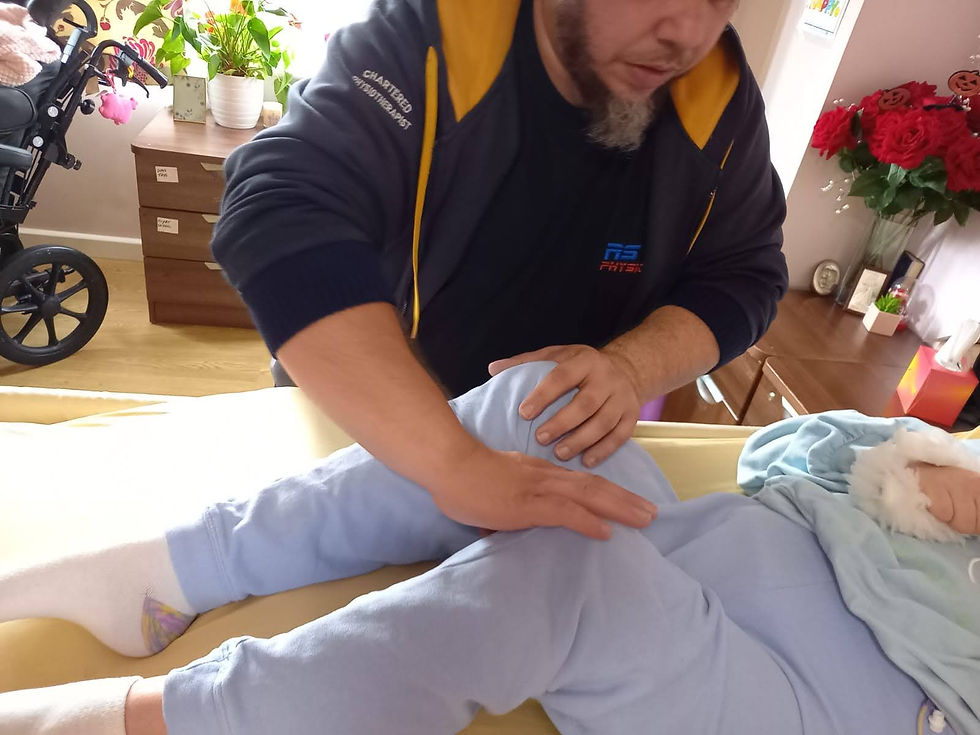Muscle Spindle: you must understand its role in muscle function and rehabilitation
- Pawel Ciecierski MSc Physiotherapy MCSP HCPCreg

- Mar 4, 2023
- 3 min read

Muscles are vital structures in the human body that allow us to perform daily activities and movements.
While the anatomy and physiology of muscles are complex, one of the key structures that play a significant role in muscle function is the muscle spindle.
In this post, I will discuss what muscle spindles are, their function, and their importance in muscle rehabilitation.
What is a muscle spindle?
A muscle spindle is a sensory organ within the muscle that detects changes in muscle length and velocity of movement. It is a specialized muscle fiber that is embedded within the muscle belly, running parallel to the extrafusal muscle fibers (the fibers that generate force during muscle contraction). The muscle spindle is composed of intrafusal muscle fibers, sensory nerve endings, and motor neurons.
Function of muscle spindle The muscle spindle plays an important role in muscle function, particularly in regulating muscle tone and providing feedback to the central nervous system (CNS) about the length and tension of the muscle.
When a muscle is stretched, the intrafusal fibers within the muscle spindle are also stretched, causing the sensory nerve endings within the spindle to send signals to the CNS. This information is then processed by the CNS, which sends motor signals to the extrafusal muscle fibers to contract, preventing the muscle from stretching too far and causing damage.
The muscle spindle also plays a role in reflexes, particularly the stretch reflex.
This reflex occurs when a muscle is suddenly stretched, causing the muscle spindle to send signals to the CNS, which then sends motor signals back to the muscle, causing it to contract. This reflex helps to maintain posture and stability during sudden changes in movement.
Importance of muscle spindle in rehabilitation The muscle spindle is an important structure in muscle rehabilitation, particularly in the treatment of muscle injuries and neuromuscular disorders.
After an injury, the muscle spindle may become hypersensitive, causing the muscle to be overly reactive and tense. This can lead to muscle imbalances, decreased range of motion, and increased risk of re-injury.
Rehabilitation techniques that focus on re-educating the muscle spindle, such as proprioceptive neuromuscular facilitation (PNF) and proprioceptive training, can help to restore normal muscle function and reduce the risk of re-injury.
Neuromuscular disorders such as cerebral palsy and multiple sclerosis can affect the function of the muscle spindle, leading to spasticity and muscle imbalances. Rehabilitation techniques that target the muscle spindle, such as sensory integration and vibration therapy, can help to improve muscle function and reduce spasticity.
Remember. The muscle spindle is a vital structure within the muscle that plays an important role in muscle function and rehabilitation. It provides feedback to the CNS about muscle length and tension, regulates muscle tone, and helps to maintain posture and stability during sudden changes in movement. Rehabilitation techniques that focus on re-educating the muscle spindle can help to restore normal muscle function and reduce the risk of re-injury. Understanding the role of the muscle spindle in muscle function and rehabilitation is an important aspect of physical therapy and can help to improve your rehabilitation outcomes.
Burke, D., & Gandevia, S. C. (2014). The human muscle spindle. In Handbook of clinical neurology (Vol. 121, pp. 167-183). Elsevier.
Houk, J. C., & Rymer, W. Z. (2011). Neural control of muscle length and tension. In Handbook of physiology: a critical, comprehensive presentation of physiological knowledge and concepts (pp. 225-244). American Physiological Society.
Edin, B. B., & Abbs, J. H. (1991). Finger movement responses of cutaneous mechanoreceptors in the dorsal skin of the human hand. The Journal of neuroscience, 11(7), 2048-2058.
Proske, U., & Gandevia, S. C. (2012). The proprioceptive senses: their roles in signaling body shape, body position and movement, and muscle force. Physiological reviews, 92(4), 1651-1697.
Corna, S., Tarantola, J., & Nardone, A. (2005). Levodopa effect on spasticity and on stretch reflexes in Parkinsonian patients. Disability and rehabilitation, 27(10), 577-583.
Chang, Y. J., Liang, C. C., Hsu, M. J., Hung, C. Y., & Huang, M. H. (2018). Effects of whole body vibration combined with sensory integrative training on motor and sensory function in children with spastic cerebral palsy: a pilot study. Journal of physical therapy science, 30(3), 412-417.
Bressel, E., McNair, P. J., & Pfeiffer, R. P. (2007). Influence of vibration frequency and amplitude on muscular performance during isokinetic exercise. Medicine and science in sports and exercise, 39(9), 1720-1728.





Comments